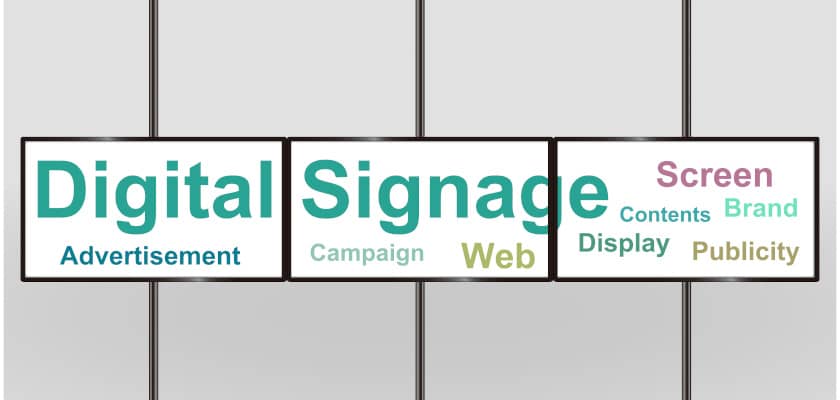Digital signage is a powerful communication tool if it’s properly designed for both accessibility and visual appeal.
You can turn your screen or TV into an attention-getting device to convey information or market your product or service. Digital signage doesn’t just grab attention. It’s cost-effective, and allows for frequent updates, and boosts impulse purchases in a retail setting.
To get the most out of your digital signage, follow these best practices for layout, dimensions, and font sizes to help you make sure you’re engaging your viewers and delivering your message.
1. Make it Legible
Legible copy is copy that’s easy to see and understand with just a glance from a distance. Keep in mind that your viewers will mostly be at least five feet to 10 feet away, so designing for this perspective will contribute to the overall success of your message.
Use these rules of thumb for styling your text.
- Use large font sizes. The ideal font size will vary depending on how far your viewer is from the screen. In lobbies and offices, they are five to 10 feet away. In restaurants and data centers, the viewer could be 30 feet away.
- Be brief. Limit the amount of text to three lines of text, each with 5 words or less, or 5 lines of text with 3 words or less.
- San Serif fonts are best. Keep to boldface sans serif fonts because they’re easier to read at a glance. Some sans serif fonts include Helvetica, Arial, Verdana, and Open Sans.
- Use two fonts or fewer. Using more than one or two fonts makes your design appear busier and difficult to read.
- Don’t use italics… Unless they are absolutely necessary because italicized text is harder to read at a glance.

2. Keep Accessibility in Mind
The U.S. Department of Justice published the Americans with Disabilities Act (ADA) Standards for Accessible Design in 2010. It specifies all electronic and information technology must be accessible to people with disabilities, and this includes digital signage. Familiarize yourself with these guidelines to make sure you are in compliance.
3. Know Your Viewing Pattern
Digital signage is most often viewed in three patterns: Point of Transit, Point of Wait or Point of Sale. You can improve the successful delivery of your message by knowing the viewing pattern for your display and designing your content to complement it.
- Point of Transit. If your sign is located in a high traffic area for walking, your signage will likely be seen at a glance. Because their interaction with your sign will be short, concise messages shown in rotation are best, and best usage includes event announcement, daily reminders and calls to action.
Keep it short (5 words or less) when designing these messages, and use a large font against a simple background. Point of Wait
- Point of wait. Interaction usually occurs in places like lobbies, elevators, service desks and waiting rooms. Viewing times are longer, which allows for longer messages for informative content like directories, news, and calendars and engaging content to shorten perceived wait times, like trivia or videos.
Interactive displays are also ideal, as your viewer is interacting for a longer period. You can show wayfinding maps, searchable directories, scrollable pages, or donor walls with search functionality.
- Point of Sale. Digital signage that’s located at the point of sale is usually viewed for longer periods, and should help people make a buying decision. This is ideal for menus, hours, promotions, discounts or sales, cross-selling and promoting high-margin merchandise or services.
Your design is extremely important for this viewing pattern. If the sign is being used to increase brand awareness, feature brand colors and styles prominently. If the sign is being used to advertise new offerings, strong design will lead to better retention of your message.
4. Be Concise
Less is more when it comes to digital signage. No one will read a long message. Stick with limited text, and massage your message until it’s as short as possible.
5. Use Visuals Wisely
While visuals are a powerful component of your design, they should add to your message, not detract from it. Don’t use complicated or unrelated images.
When designing graphics or creating video, do it in a size that ideally matches or exceeds the resolution of the output device to avoid images looking pixelated or distorted. If you don’t already have content, you can start with an animated template, or choose one of the thousands of free available templates available in our Canva integration.
If you design in common aspect ratios like 4:3, 16:9, 2:1, it will allow you to easily repurpose your designs for other projects.
6. Use a Strong Call-to-Action
If you use a call-to-action as part of your messaging, be sure you’re very clear about what you want them to do. Be precise by giving dates, times and locations, and contact information, if need be.
7. Schedule Properly
Timing, really, is everything, so consider the nature of the environment and time accordingly and schedule your presentations to change according to the dynamic of the space.
For example, in a medical office, things generally move at a slow pace, so transitions between presentations can occur less frequently. However, in a busy corridor, transitions should occur frequently because the viewing time is much shorter.
8. Experiment and Learn
If you’re not sure something will work, test it. Try it for a day and observe reactions and make changes for the next day if needed, and so on. Using this strategy will help you perfect and adjust your message to fit the audience and the location to have the desired impact.
Conclusion
Remember, 90% of the information transmitted to your brain is visual, and after three days, people retain 65% of visually presented information. By following these best practices, you’ll be able to make the most of your digital signage.
Ready to engage your audience with digital signage? Click here to learn more today.

